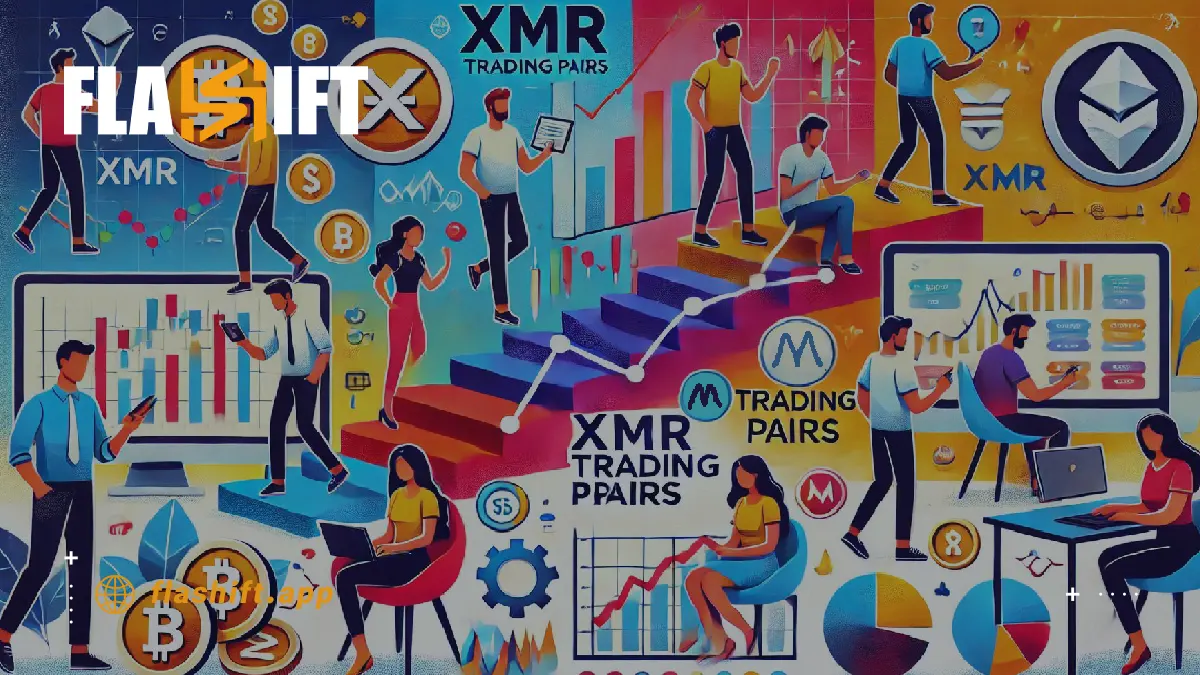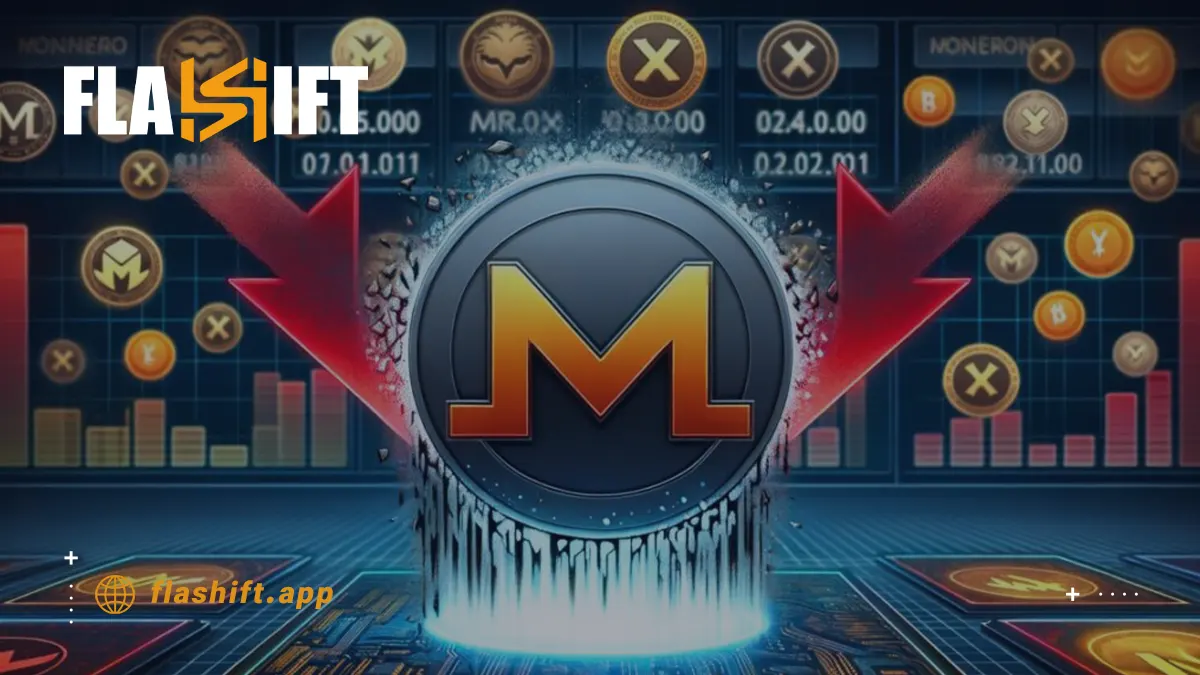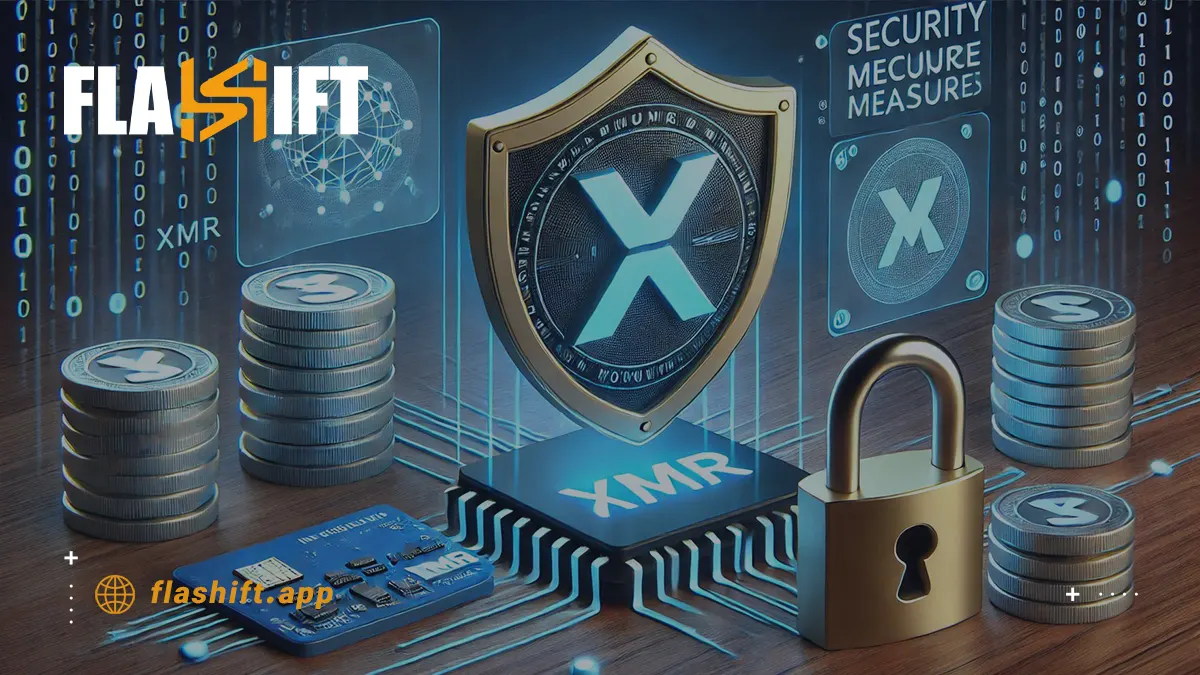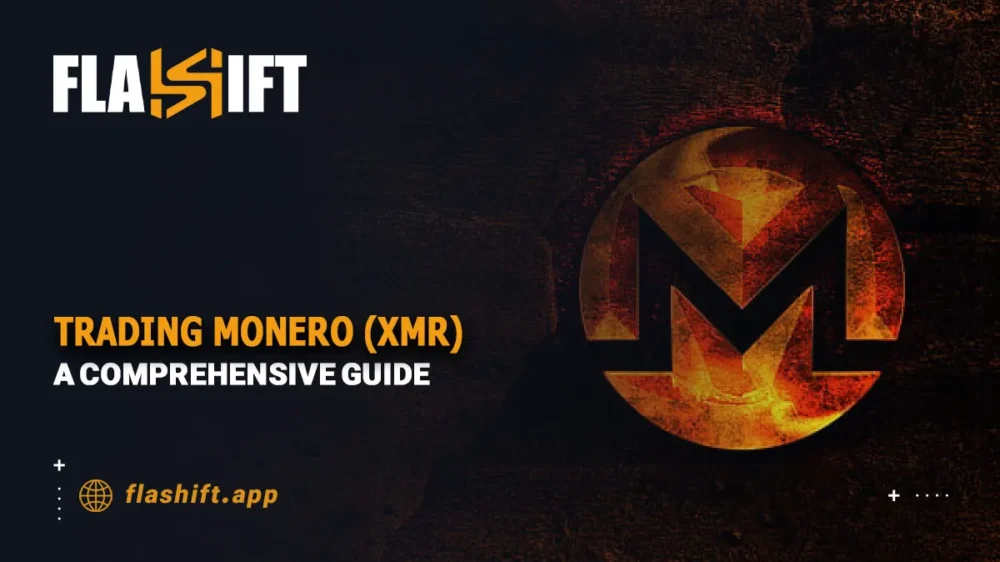- What is Monero (XMR) and Its Unique Features?
- Why Trade Monero?
- Common Risks in XMR Trading
- Getting Started: Setting Up Your Trading Accounts
- Step 1: Choose a Reputable Exchange
- ❌ Exchanges That Removed XMR Support
- Step 2: Register for an Account
- Step 3: Complete Identity Verification (KYC)
- Step 4: Secure Your Account
- Step 5: Fund Your Account
- Step 6: Locate Monero Trading Pairs
- Step 7: Start Trading
- Regulatory Considerations for Privacy-Focused Cryptocurrencies
- Trading Pairs Explained: XMR/USDT, XMR/BTC, and XMR/ETH
- How to Trade XMR Trading Pairs
- No Registration, KYC-Free!
- Security Measures: Safeguarding Your XMR Transactions
- Fees and Costs: What to Expect When Trading XMR
- Conclusion: Navigating the XMR Trading Landscape
- FAQ
Trading Monero Comprehensive Guide | Monero (XMR) is one of the most popular cryptocurrencies due to its emphasis on privacy and security. It has, therefore, gained massive attention among cryptocurrency traders. Being at the forefront of digital currency, XMR boasts unique features that attract traders searching for anonymity and decentralization. Whether you are a professional trader or a beginner, learning how to effectively exchange XMR for popular cryptocurrencies such as USDT, BTC, and ETH is crucial.
This comprehensive guide explains the specifics of Monero trading, from selecting appropriate exchange sites to optimizing your trading approach. Learn how to exchange XMR smoothly and realize your full trading potential within the dynamic modern cryptocurrency market.
What is Monero (XMR) and Its Unique Features?
Monero (XMR) is a privacy-centered cryptocurrency that launched in April 2014 as a fork of Bitcoin, built on the CryptoNote protocol . Designed for true anonymity, Monero employs several advanced cryptographic techniques by default. Ring signatures mix each transaction sender with decoy participants, obscuring the true source . Stealth addresses generate one-time recipient addresses, hiding where funds are sent . Ring Confidential Transactions (RingCT) obscure transaction amounts from public view . Its network is secured by RandomX, an ASIC-resistant PoW algorithm introduced in late 2019, which encourages CPU-based mining and further decentralization. Altogether, these features make Monero one of the most private and fungible cryptocurrencies available today.
Key Privacy Features of Monero:
- Ring Signatures:
Ring signatures mix a user’s transaction data with that of others, making it nearly impossible to determine the trustworthy source of a transaction. This ensures sender anonymity while maintaining the integrity of the network. - Stealth Addresses:
Monero generates one-time use addresses for every transaction, preventing third parties from linking transactions to specific recipients. This adds another layer of privacy for users. - Confidential Transactions (RingCT):
RingCT hides the amount being transacted in each transfer, ensuring that transaction amounts are invisible to anyone other than the involved parties.
To exchange Tether (USDTERC20) to Monero (XMR) in one second, Flashift is the easiest way.
Monero’s Role in the Cryptocurrency Market:
Monero’s privacy attributes make it highly fungible, which is a necessary feature for any currency that aims to be a suitable medium of exchange. While other cryptocurrencies leave a clear trail of transactions, Monero obscures the origin of coins, making it appealing for individuals and businesses.
While the anonymity features of Monero have brought the regulators’ attention to themselves, they also speak to its potential to empower users in an increasingly transparent and centralized financial ecosystem. With the growth in demand for privacy, Monero continues to solidify its position as a leading digital asset, playing a key role in shaping the focus of the cryptocurrency market on confidentiality and decentralization.
Why Trade Monero?

Trading Monero brings together the advantages of privacy, security, and market potential. Whether protecting your financial activities, investing in a reliable digital asset, or leveraging the trading opportunities of the cryptocurrency market, Monero is a great choice. Its unique features and growing role in the digital economy keep attracting traders who value confidentiality and security. Here’s why trading Monero is a smart choice:
-
Privacy-Centric Features
Advanced privacy features are one of the unique differentiators of Monero when compared to other cryptocurrencies. Every transaction on the blockchain is confidential, cloaking the transaction’s sender, receiver, and amount. This level of unprecedented privacy ensures that your financial activities remain private and impervious to prying eyes, an invaluable feature in an era of increasing digital surveillance.
-
Monero Security
Security is at the core of Monero’s design. Its decentralized network is safeguarded by proof-of-work consensus, ensuring resilience against attacks. Monero’s use of ring signatures and stealth addresses eliminates vulnerabilities associated with traceable blockchain data, providing traders with a secure transaction platform.
-
Fungibility
Unlike many cryptocurrencies, Monero is fully fungible—meaning every unit of XMR is identical and interchangeable. Since transaction histories are private, no coin can be blocked or deemed “tainted,” making Monero an ideal asset for seamless and unrestricted trading.
-
Market Opportunities
Monero’s growing adoption in privacy-conscious communities and regions offers dynamic market opportunities. Its high trading volume and liquidity on significant exchanges, coupled with its consistent price volatility, create an ideal environment for traders to capitalize on short- and long-term price movements.
-
Decentralization and Independence
As a truly decentralized cryptocurrency, Monero operates without a central authority. Its community-driven development and resistance to censorship make it a trusted option for traders seeking autonomy in their financial transactions.
To exchange Monero (XMR) to Ethereum (ETH) in one second, Flashift is the easiest way.
Common Risks in XMR Trading
1. Regulatory Crackdowns and Wallet Blacklisting
Because Monero (XMR) is a privacy-focused cryptocurrency, it has faced increasing scrutiny from governments and regulators. In some countries, exchanges have been forced to delist Monero or block wallets suspected of facilitating illicit transactions. Traders must stay informed about regional regulations and ensure they are using platforms that legally support XMR trading.
2. Fake Swap Sites or Impersonator Wallets
Due to Monero’s anonymous nature, it’s a frequent target for phishing schemes. Fake swap platforms often mimic legitimate services and steal user funds. Similarly, malicious wallet clones may capture private keys. Always verify URLs, use bookmarks for trusted services, and download wallets only from official or audited sources.
3. Slippage and Delays in Atomic Swap Protocols
When using atomic swaps or decentralized exchange protocols, users may experience slippage—a difference between expected and executed price—especially in low-liquidity trading pairs. Additionally, swaps involving Monero can take longer due to the complexity of its privacy features and confirmation requirements. It’s important to monitor transaction progress and be aware of time-lock limitations in HTLC-based swaps.
Getting Started: Setting Up Your Trading Accounts
Trading Monero (XMR) begins with choosing a reliable exchange where you can create an account and start trading XMR with popular pairs such as XMR/USDT, XMR/BTC, and XMR/ETH. Below, we will explain the step-by-step process to ensure you can confidently set up your trading account.

Step 1: Choose a Reputable Exchange
The first step is selecting a cryptocurrency exchange that supports Monero trading pairs. Several exchanges offer robust security and a wide range of trading options.
Where Can You Trade Monero Today?
Despite growing regulatory pressure, Monero (XMR) remains tradable through decentralized and peer-to-peer channels in 2025. While many centralized exchanges have removed support due to compliance concerns, traders still have solid options:
✅ Best Decentralized Exchanges (DEXs)
-
Haveno – A privacy-first DEX built on Monero’s codebase, fully anonymous and Tor-friendly.
-
Bisq – A decentralized Bitcoin exchange that supports XMR via fiat and BTC pairings.
-
TradeOgre – A lightweight crypto exchange known for supporting privacy coins like Monero.
✅ Peer-to-Peer (P2P) Platforms
-
LocalMonero – One of the longest-standing P2P platforms, enabling Monero trades without KYC.
-
AgoraDesk – A privacy-focused marketplace offering both crypto and fiat XMR trades worldwide.
✅ Cross-Chain Swaps with Flashift
Flashift provides non-custodial, anonymous swaps between Monero and other major cryptocurrencies like BTC, ETH, and USDT—no account or KYC required, making it ideal for fast and private conversions.
❌ Exchanges That Removed XMR Support
Due to compliance with global anti-money laundering (AML) regulations, several major exchanges have delisted XMR in recent years, including:
-
Binance
-
Huobi
-
Kraken
As a result, centralized XMR trading options are increasingly limited or geo-restricted.
Step 2: Register for an Account
Once you’ve chosen an exchange, the next step is to sign up for an account. Below are the steps to register:
a. Visit the Exchange Website
To avoid phishing websites, go to the exchange’s official website. Always check the URL to ensure that you’re using the authentic website.
b. Create an Account
- Sign Up: Click the “Sign Up” or “Register” button. You will be asked to provide your email address and create a strong password. For better security, use a combination of letters, numbers, and symbols.
- Email Verification: Check your inbox for a verification email after signing up. Click on the verification link to confirm your registration.
- Set Up Account Preferences: Some exchanges will ask for additional details, such as your country of residence or preferred currency.
Step 3: Complete Identity Verification (KYC)
Because of crypto regulations, most exchanges require Know Your Customer (KYC) verification. KYC helps ensure that the exchange operates securely and can prevent fraud or illegal activities.
Step 4: Secure Your Account
To protect your funds, it’s crucial to set up account security features like Two-Factor Authentication (2FA) and Withdrawal Allowlisting.
Enable Two-Factor Authentication (2FA):
2FA adds an extra layer of security by requiring a second authentication method, typically via a smartphone app like Google Authenticator or Authy.
- After enabling 2FA, you must enter a code from the app each time you log in or make transactions.
Set Up Withdrawal Allowlisting:
Withdrawal allowlisting allows you to specify a set of approved wallet addresses. Only funds sent to these addresses can be withdrawn, adding another layer of protection in case of account breaches.
Create a Strong Password:
Choose a password that’s unique and difficult to guess. Combine uppercase and lowercase letters, numbers, and symbols for better security. Avoid using passwords you’ve used elsewhere.
Step 5: Fund Your Account
Once your account is secure, you need to deposit funds into it. You can fund your exchange account in several ways:
a. Deposit Cryptocurrency
If you already hold cryptocurrencies like BTC, ETH, or USDT, you can deposit them into your exchange wallet.
b. Buy Cryptocurrency with Fiat
Some exchanges allow you to buy crypto directly with fiat currencies (USD, EUR, etc.). You can use your credit/debit card or bank transfer to deposit fiat and buy BTC, ETH, or USDT. These funds can then be traded for Monero (XMR).
Step 6: Locate Monero Trading Pairs
Now that your account is funded, it’s time to trade! Navigate to the exchange’s trading section and search for Monero (XMR) trading pairs.
Common XMR Trading Pairs:
- XMR/USDT: Trading Monero against Tether (USDT), a stablecoin pegged to the US dollar.
- XMR/BTC: Trading Monero against Bitcoin (BTC), one of the most popular cryptocurrencies.
- XMR/ETH: Trading Monero against Ethereum (ETH), a widely used cryptocurrency known for its smart contract functionality.
Select the pair that matches your trading goals and click on it to view the market.
Step 7: Start Trading
You can place your first order once you’ve selected the trading pair. Exchanges typically offer different types of orders that we will explain in the “How to Trade XMR Trading Pairs” section.
Regulatory Considerations for Privacy-Focused Cryptocurrencies
When trading Monero (XMR), it is essential to understand the regulatory landscape surrounding privacy-focused cryptocurrencies. Monero’s emphasis on transaction anonymity and privacy has gained popularity among individuals prioritizing financial security, but it has also drawn scrutiny from governments and regulators worldwide. Due to concerns about potential misuse in activities like money laundering or tax evasion, certain countries have enacted restrictions or even outright bans on trading or using Monero.
For traders, these developments highlight the importance of researching and complying with local regulations, as rules regarding cryptocurrencies can vary significantly across regions. For example, in certain jurisdictions, exchanges may not support Monero due to regulatory pressure, limiting the availability of trading pairs like XMR/BTC or XMR/ETH on mainstream platforms. Monitoring these developments is critical not just for avoiding compliance issues but also for assessing how changes in regulation may affect Monero’s market demand and price volatility.
In addition, the anonymous nature of Monero transactions can make tax reporting more complicated. Traders should consider maintaining transparent records of trades to ensure compliance with tax laws, as failure to report cryptocurrency gains can result in penalties. By staying informed about regulatory updates and adopting proper record-keeping practices, traders can mitigate risks while leveraging Monero’s privacy features effectively.
Trading Pairs Explained: XMR/USDT, XMR/BTC, and XMR/ETH
When trading Monero (XMR), understanding the trading pairs is crucial to making informed decisions. A trading pair indicates the two assets being exchanged. For Monero, common pairs include XMR/USDT, XMR/BTC, and XMR/ETH. Each pair has unique characteristics and advantages, which we’ll explore in detail below.

-
XMR/USDT: Trading Monero Against Tether
Monero (XMR) is traded against Tether (USDT), a stablecoin pegged to the US dollar in this pair. It allows traders to exchange Monero directly for a dollar-equivalent asset.
Advantages of XMR/USDT:
- Price Stability: Since USDT is a stablecoin, its value remains relatively constant, minimizing exposure to volatility compared to trading against cryptocurrencies like BTC or ETH.
- Ease of Entry and Exit: XMR/USDT simplifies trading for those who think in terms of fiat currency (e.g., USD). Profits and losses are more straightforward to calculate in dollar terms.
- Lower Volatility Risks: Ideal for traders who want to manage risk and avoid exposure to the volatility of other cryptocurrencies.
When to Use XMR/USDT:
- When converting Monero to a stable asset to hedge against market volatility.
- When you’re primarily focused on measuring profits or losses in fiat currency terms.
-
XMR/BTC: Trading Monero Against Bitcoin
In this pair, Monero is traded against Bitcoin (BTC). Traders exchange Monero directly for Bitcoin and vice versa.
Advantages of XMR/BTC:
- High Liquidity: BTC is the most traded cryptocurrency, so XMR/BTC pairs often have high liquidity, enabling faster trades and smaller spreads.
- Relative Valuation: This pair helps traders assess Monero’s performance relative to Bitcoin, often seen as a benchmark in the crypto market.
- Potential Gains from BTC Price Movements: If Bitcoin appreciates, gains in BTC holdings can compound.
When to Use XMR/BTC:
- When comparing Monero’s performance against Bitcoin’s market movements.
- For traders holding Bitcoin as a long-term asset and wanting to diversify into Monero without converting to fiat.
-
XMR/ETH: Trading Monero Against Ethereum
What It Means:
In this pair, Monero is traded against Ethereum (ETH). Traders can exchange Monero for Ethereum and vice versa.
Advantages of XMR/ETH:
- Diversification Between Privacy and Smart Contract Ecosystems: Monero focuses on privacy, while Ethereum is a leading platform for decentralized applications. This pair lets traders shift between two distinct use cases.
- Access to Ethereum’s Growing Ecosystem: Traders can trade Monero for Ethereum and then use ETH for staking, DeFi, or other applications within the Ethereum network.
- Volatility Opportunities: Both Monero and Ethereum are subject to market fluctuations, which offer traders the opportunity to profit from price differences.
When to Use XMR/ETH:
- When diversifying into Ethereum’s ecosystem for additional investment opportunities.
- This is for traders who closely follow Ethereum’s market trends and anticipate favorable shifts in ETH value relative to XMR.
Key Considerations When Choosing a Trading Pair
| Factor | XMR/USDT | XMR/BTC | XMR/ETH |
| Market Goals | Ideal for traders focused on stability and measuring profits/losses in fiat currency. | Suitable for those comparing Monero’s performance relative to Bitcoin or holding BTC long-term. | Best for diversifying into Ethereum’s ecosystem or capitalizing on ETH market trends. |
| Liquidity | Typically offers high liquidity and faster execution due to USDT’s widespread use. | High liquidity with tight spreads since BTC is the most traded cryptocurrency. | Some exchanges may have lower liquidity than XMR/USDT and XMR/BTC. |
| Volatility | Minimizes volatility risks as USDT is pegged to the US dollar. | Higher volatility due to fluctuating BTC prices offers more profit potential. | Subject to significant price swings from both Monero and Ethereum markets. |
| Trading Fees | Generally, there are lower fees on most exchanges for USDT-based pairs. | Fees may vary; some exchanges incentivize BTC pairs with reduced rates. | Fees could be slightly higher due to lower trading volume in this pair. |
| Arbitrage | Helpful in spotting price differences between fiat and crypto markets. | It provides opportunities to exploit price variations between Monero and Bitcoin exchanges. | Allows traders to benefit from differences between Monero and Ethereum prices on exchanges. |
This table helps visualize the differences, making choosing the right Monero trading pair easier based on your needs and trading strategy.
Read More: Monero Mining: A Beginner’s Guide to Privacy-Centric Mining
How to Trade XMR Trading Pairs
When trading Monero (XMR) for another crypto (USDT/BTC/ETH), you can choose between market orders for instant execution or limit orders to set a preferred price. Below, I’ll explain both methods in detail, covering each step so you can trade confidently on any reputable exchange. Here, the trading pair XMR/USDT is described as an example. However, this tutorial applies to all Monero trading pairs.

Step 1: Place a Market Order (Instant Execution)
A market order is the quickest way to trade XMR for USDT. This order type will automatically execute at the best available price in the market.
How to Place a Market Order:
- Select the XMR/USDT Trading Pair
-
- Go to the trading section of your exchange.
- In the “Markets” or “Trading Pairs” search bar, type in XMR/USDT. This will show the market for trading Monero against Tether.
- Click on the XMR/USDT pair to open the trading interface.
- Choose “Market Order”
-
- < UNK> The trading page shows different order types (market, limit, stop). Select Market Order.
- A market order will immediately execute the trade at the current market price without requiring you to set the price manually.
- Enter the Amount of XMR to Sell
-
- In the order entry box, enter the amount of XMR you wish to exchange for USDT.
- You may have the option to use buttons like “Sell All” (to sell your entire XMR balance) or specify a custom amount.
- The amount will be converted into USDT based on the current market rate.
- Review and Confirm the Order
-
- The platform will show you an estimated amount of USDT you’ll receive based on the current market price.
- Double-check everything is correct, then click the “Sell XMR” button to confirm your market order.
- Your order will be filled instantly at the best available price.
- Order Execution
-
- Once you confirm, the order will execute at the market price, and the USDT equivalent will be credited to your exchange account.
- You can view the transaction in your “Order History” or “Trade History” section, showing the filled price and amount.
Step 2: Place a Limit Order (Set Your Price)
A limit order allows you to specify the price you’re willing to trade XMR for USDT. The order will only be filled when the market price reaches your specified price.
How to Place a Limit Order:
- Select the XMR/USDT Trading Pair
-
- Just as with the market order, start by navigating to the XMR/USDT pair in your exchange’s trading section.
- Choose “Limit Order”
-
- In the order type options (usually above the price chart), select Limit Order.
- This allows you to define the exact price you want to sell your XMR.
- Set the Limit Price
-
- Enter your desired price for selling XMR in terms of USDT.
- For example, if you want to sell XMR when the price reaches $150, you would set the limit price to 150 USDT per XMR.
- The limit order will remain pending until the market price hits or exceeds your limit price.
- Enter your desired price for selling XMR in terms of USDT.
- Enter the Amount of XMR to Sell
-
- In the “Amount” box, specify how much XMR you want to trade for USDT.
- You can sell a portion of your XMR balance or the entire amount.
- Your order will only be filled if the price reaches your set limit.
- Review and Confirm the Order
-
- Double-check the price and quantity you’ve entered.
- When satisfied with the settings, click “Sell XMR” to place the limit order.
- Your order will appear in the “Open Orders” section and remain pending until the price matches your limit.
- Order Execution
-
- If the market price hits your limit, the exchange will automatically execute your order and sell XMR at that price.
- If the price doesn’t reach your limit, the order will stay open, and you can modify or cancel it anytime.
Step 3: Monitor Your Order
- For Market Orders:
-
- Market orders are filled immediately, so you don’t need to monitor them.
- Once the trade is executed, the USDT equivalent will be in your account, and you can withdraw or use it as you see fit.
- For Limit Orders:
-
- Limit orders stay open until they are filled or canceled.
- You can check your open orders in the “Open Orders” section of the exchange.
- If the price doesn’t reach your limit, the order remains pending. If you want to modify the price, you can update it or cancel the order and place a new one.
Key Considerations for Trading XMR for USDT
| Consideration | Market Orders | Limit Orders |
| Execution Speed | Instant execution at the current market price. | Order is filled only when the market reaches the specified price. |
| Price Control | There is no control over the execution price, as it’s based on market conditions. | Complete control over the price at which your XMR is sold. |
| Slippage | May experience slippage (difference between expected and actual price) in volatile markets. | There is no slippage, as the order will only execute at the set price. |
| Order Expiry | Orders are filled immediately and don’t expire. | Orders remain open until filled or canceled. Some exchanges allow setting an expiry time. |
| Fees | Typically, higher fees are due to immediate execution. | Lower fees, but depends on market conditions and execution speed. |
| Market Impact | Executes at the current best available price, affecting market depth. | You may not execute if the market price doesn’t meet your specified price. |
| Risk | There is minimal risk of unfilled orders, but slippage could lead to a worse price. | Risk of not getting filled if the market doesn’t reach your limit price. |
This table summarizes the key differences and considerations between market and limit orders when trading XMR for USDT.
No Registration, KYC-Free!
Flashift.app offers a simple and secure platform for exchanging Monero (XMR) without registering or completing a KYC process. This feature makes it an attractive option for traders who value privacy and wish to avoid lengthy sign-up procedures.
Key Features of Flashift.app for Exchanging Monero:
- No Registration Required: You can exchange Monero (XMR) for other cryptocurrencies or stablecoins like USDT, BTC, and ETH without creating an account or providing personal information. This ensures that your trading activity remains anonymous and fast.
- KYC-Free Trading: The Flashift app does not require users to go through the KYC process, allowing for a more private and streamlined trading experience. This feature particularly appeals to those who want to maintain confidentiality while trading.
- Simple User Interface: The platform is designed for ease of use, allowing even novice traders to exchange Monero for their desired cryptocurrency without complex steps quickly. The interface is intuitive, with clear instructions on how to proceed with the trade.
- Security and Privacy: The Flashift app emphasizes user privacy, ensuring that no sensitive personal data is collected during the transaction process. With Monero’s built-in privacy features and Flashift’s focus on confidentiality, your funds and transaction details are protected.
- Fast Transactions: The exchange process on the Flashift app is fast, allowing users to exchange Monero and other cryptocurrencies quickly without waiting for lengthy verification processes. The platform supports instant trades with competitive rates.
- Multiple Cryptocurrencies Supported: The Flashift app supports a variety of cryptocurrencies for exchange, including XMR/USDT, XMR/BTC, and XMR/ETH, giving you flexibility in trading based on your preferences.

How to Exchange Monero on the Flashift.app:
- Visit the Flashift.app website.
- Select Monero (XMR) as the cryptocurrency you want to exchange.
- Choose the cryptocurrency (e.g., USDT, BTC, ETH) you want in return.
- Enter the recipient address for the cryptocurrency you’re exchanging.
- Confirm the transaction details and proceed with the exchange.
- Complete the transaction and receive your new cryptocurrency in your wallet.
Exchanging Monero (XMR) without registration and KYC on the Flashift.app provides an efficient, secure, and private way to manage your trades. Whether you’re looking to convert Monero into other cryptocurrencies or want a hassle-free trading experience, the Flashift.app allows you to do so quickly while maintaining your privacy.
Security Measures: Safeguarding Your XMR Transactions
When trading Monero (XMR), it’s essential to implement strong security measures to protect your funds and personal data. Here are best practices to ensure the safety of your XMR transactions and assets.

-
Enable Two-Factor Authentication (2FA)
Two-factor authentication (2FA) requires a second verification step—usually a code sent to your phone or email—when logging into your exchange account or performing sensitive actions like withdrawals. 2FA adds an extra layer of protection by making it much harder for hackers to access your account, even if they have your password.
-
Use Hardware Wallets for Storage
A hardware wallet is an actual physical device storing your private keys offline. Popular choices for Monero include Ledger Nano X or Trezor. Keeping your XMR in one minimizes the chances of being hacked or facing malware issues online. It provides a way for your money to remain secure, even when an account on some exchange is compromised.
-
Withdraw to a Safe Wallet
After purchasing or trading XMR, always withdraw your funds to a secure cold or hardware wallet. Leaving your XMR on an exchange exposes it to risks such as hacking, exchange closures, or phishing attacks. By withdrawing your assets to a private wallet, you retain complete control over them.
-
Enable Withdrawal Allowlists
Withdrawal allowlists allow you to specify a trusted wallet address for withdrawals. Only transactions sent to the allowed address will be approved. This significantly prevents unauthorized withdrawal attempts if your exchange account is compromised.
-
Use Strong and Unique Passwords
Always create strong, complex passwords that include a mix of letters, numbers, and special characters. Also, avoid using common phrases or sets of words or easy-to-guess passwords. A weak password makes it easier for the hacker to access your account. A strong password, in combination with 2FA, will significantly reduce the possibility of a breach.
-
Be Aware of Phishing Scams
Phishing attacks involve tricking you into entering sensitive information (like your login credentials) on fake websites or through fraudulent emails. Please always double-check URLs and be careful of unsolicited messages that ask for personal details or login information. Could you verify the legitimacy of the platform before entering any data?
-
Monitor Your Accounts Regularly
For suspicious activity, please check your exchange accounts, wallets, and transaction history. Early detection of unauthorized transactions or attempts can help you act quickly to secure your assets.
Best Platforms for XMR Exchange
To trade Monero (XMR) securely, using a reputable and secure exchange is essential. Here are some of the best platforms for exchanging Monero:
| Exchange Platform | Security Features | Trading Pairs Available |
| Binance | 2FA, cold storage, regular security audits | XMR/USDT, XMR/BTC, XMR/ETH |
| Kraken | 2FA, SSL encryption, security best practices | XMR/USD, XMR/EUR, XMR/BTC |
| KuCoin | 2FA, cold storage, risk management protocols | XMR/USDT, XMR/BTC, XMR/ETH |
| Gate.io | 2FA, cold wallets, encryption, security audits | XMR/USDT, XMR/BTC, XMR/ETH |
| Bittrex | 2FA, cold storage, advanced security measures | XMR/USDT, XMR/BTC, XMR/ETH |
These platforms are known for their commitment to security, ensuring that your XMR trades and assets are protected. You can always choose an exchange that aligns with your security preferences and trading needs.
Fees and Costs: What to Expect When Trading XMR
Understanding the various fees involved when trading Monero (XMR) is crucial for managing costs and maximizing the efficiency of your trades. Here is an overview of the typical expenses associated with XMR trades and strategies to minimize them.

-
Trading Fees
Trading fees are charged when you execute a buy or sell order on an exchange. These fees are usually a percentage of the trade amount and can vary depending on the exchange and your account status.
- How it works:
- Market Orders Often incur higher fees since they are executed instantly at the best available market price.
- Limit Orders typically have lower fees because they remain in the order book and execute when the market reaches your price.
- Example Fees:
- Binance: 0.1% for both makers and takers, with potential reductions based on trading volume or using Binance Coin (BNB).
- Kraken: Fees range from 0.16% to 0.26% for makers and 0.20% to 0.30% for takers, depending on your 30-day trading volume.
-
Deposit Fees
Some exchanges charge fees for depositing funds into your account, especially if you’re depositing XMR or other cryptocurrencies.
- How it works:
- Monero Deposits: Typically, depositing Monero into an exchange is free of charge on many platforms. However, if you’re transferring XMR from an external wallet to an exchange, check if any network fees apply (Monero uses a dynamic transaction fee based on network congestion).
- Crypto-to-Crypto Deposits: Some exchanges offer free deposits for crypto-to-crypto transfers, but always check for hidden fees.
-
Withdrawal Fees
Withdrawal fees apply when you transfer your XMR or other assets from the exchange to your wallet or another exchange.
- How it works:
- Monero Withdrawal Fees: XMR withdrawal fees vary between exchanges, depending on the Monero network’s current congestion and the platform’s policy. On average, XMR withdrawal fees can range from 0.0001 to 0.001 XMR, which could be higher during network congestion.
- Example Fees:
- Binance: Around 0.0001 XMR for withdrawing Monero to an external wallet.
- Kraken: Fees typically range between 0.001 XMR and 0.002 XMR, depending on the network’s load.
-
Conversion Fees
Some exchanges charge additional fees for the conversion process if you’re converting XMR to another cryptocurrency or stablecoin (like USDT, BTC, or ETH).
- How it works:
- Spread: The difference between the buying and selling prices is often considered an indirect fee, especially when converting XMR into a different cryptocurrency. A higher spread can indicate less liquidity in the trading pair.
- Example Fees:
- Kraken: Typically, there is a small spread when converting XMR into another crypto or fiat currency.
- Binance: Conversion fees are often embedded within the spread.
-
Network Fees
Network fees refer to the transaction costs of transferring XMR on the Monero blockchain.
- How it works: Every transaction on the blockchain requires a fee to incentivize miners to process it. Monero uses a dynamic fee system, which can fluctuate depending on network congestion. While it’s typically low (around 0.0001 XMR), it can increase during high transaction volume.
- Example Fees:
- Typically, it ranges from 0.0001 to 0.001 XMR, depending on the transaction size and network activity.
How to Minimize Trading Fees
Here’s a table summarizing how to minimize fees when trading XMR:
| Method | Description |
| Use Limit Orders | Limit orders typically have lower fees than market orders, as they provide liquidity to the order book. |
| Trade on Low-Fee Exchanges | Choose exchanges with competitive trading fees. Some exchanges offer lower fees or discounts for high-volume traders. |
| Use Withdrawal Fee Discounts | Some exchanges offer discounts for withdrawal fees if you use the exchange’s native token (e.g., Binance Coin on Binance). |
| Withdraw During Low Network Congestion | Network fees for Monero transactions vary depending on congestion. To lower costs, withdraw when the network is less congested. |
| Take Advantage of Fee Promotions | Exchanges may run promotions that waive or reduce trading or withdrawal fees. Please be on the lookout for these offers to save costs. |
Conclusion: Navigating the XMR Trading Landscape
Trading Monero requires being cautious, strategizing, and making secure investments. Given its private nature, XMR has become the most sought-after for traders seeking some security in anonymity against the more mainstream cryptocurrencies. This cryptocurrency market is very volatile, and keeping yourself in the know is a priority. Regularly monitoring the price trend, market sentiments, and regulatory news concerning privacy coins will help make calculated decisions and minimize risks in Monero trading.
In addition to market knowledge, safeguarding your assets is paramount. Utilizing two-factor authentication (2FA), storing XMR in hardware wallets, and being cautious of phishing scams are essential to protecting your funds. Furthermore, using innovative trading strategies like limit orders to reduce fees or setting price alerts can help you make more profitable trades. By staying proactive, informed, and secure, you can successfully navigate the XMR trading landscape while minimizing risks and maximizing opportunities.
FAQ
- What is Monero (XMR), and why is it valuable?
Monero (XMR) is a privacy-focused cryptocurrency that provides anonymous transactions. Its value comes from its strong privacy features, differentiating it from other cryptocurrencies like Bitcoin and Ethereum.
- Which exchanges support XMR trading pairs?
Popular exchanges that support XMR trading pairs include Binance, Kraken, KuCoin, Gate.io, and Bittrex. They offer pairs like XMR/USDT, XMR/BTC, and XMR/ETH.
- How do I trade XMR for USDT?
To trade XMR for USDT, sign in to an exchange that supports this pair, deposit your XMR, and place a market or limit order to convert it into USDT.
- What are the main trading pairs for XMR?
The most common XMR trading pairs are XMR/USDT, XMR/BTC, and XMR/ETH, which allow you to trade Monero against stablecoins or other cryptocurrencies like Bitcoin and Ethereum.
- How can I minimize trading fees when exchanging XMR?
You can minimize fees by using limit orders instead of market orders, choosing low-cost exchanges, and withdrawing during low network congestion.
- Is Monero (XMR) a secure cryptocurrency to trade?
Monero is known for its strong security features, including private transactions and untraceable addresses, making it a secure choice for traders who prioritize privacy.
- How do I secure my XMR assets when trading?
To secure your XMR, use two-factor authentication (2FA) on exchanges, store your coins in hardware wallets, and be cautious of phishing scams. Also, monitor your accounts regularly for suspicious activity.







